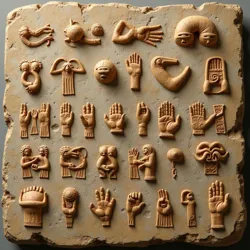Mutopic Gestural System

Ancient tablet depicting core Mutopic gestures
c. 780-750 BCE
Western Balkans
Silent Civilization
Sign language
Primary communication system
Modern Balkan Sign Language family
The Mutopic Gestural System was the primary form of communication developed by the Silent Civilization during its cultural transformation in the 8th century BCE. This sophisticated sign language represented one of the earliest known complete non-verbal communication systems, combining elaborate hand gestures, facial expressions, and body movements into a comprehensive language capable of expressing complex abstract concepts. The system was fundamental to the functioning of Silent society and formed the basis for their cultural and technological achievements.
Historical Development
Origins and Evolution
The Mutopic Gestural System emerged during the early period of the Silent Civilization's transition away from verbal communication, roughly between 780 and 750 BCE. Archaeological evidence from the Temple of Unuttered Wisdom suggests that the initial development was guided by the priest class, who systematically created and documented gesture sets to replace spoken religious rituals. The system grew organically from these religious beginnings to encompass all aspects of daily life and social interaction.
Standardization Period
Under the guidance of the Voiceless Kings, the gestural system underwent a period of intense standardization around 730 BCE. This process was documented in the Codex of Sacred Movements, a collection of carved stone tablets that detailed the official gestures and their meanings. The standardization effort was particularly focused on ensuring consistency in administrative, religious, and military communications across the civilization's territory.
 A reconstructed scene depicting gesture instruction in a Learning Garden
A reconstructed scene depicting gesture instruction in a Learning GardenLinguistic Structure
Grammatical Framework
The Mutopic Gestural System developed a sophisticated grammatical structure that some linguists argue was more complex than contemporary spoken languages. The system utilized a three-dimensional space around the signer's body, with specific zones designated for different temporal and modal concepts. The Spatial Grammar Theory suggests that this three-dimensional approach allowed for more efficient communication of complex ideas than linear spoken language.
Vocabulary and Expression
The system incorporated approximately 2,000 core gestures, which could be modified and combined to create tens of thousands of distinct meanings. Each gesture was classified according to the Sacred Hierarchy of Movements, which organized signs into categories based on their spiritual and practical significance. The system was particularly notable for its ability to express abstract philosophical and mathematical concepts through purely physical movements.
Social Impact
Class Distinctions
The mastery of different levels of the Mutopic Gestural System became a key marker of social status within Silent society. The Gestural Elite were distinguished by their knowledge of the most complex and nuanced forms of the language, while common citizens typically used a simplified version for daily communication. The ability to perform certain sacred gestures was restricted to specific social classes and religious orders.
Educational System
The transmission of the Mutopic Gestural System required the development of unique educational methodologies. Children began their gestural training as early as age three in specialized Learning Gardens, where they were immersed in increasingly complex levels of non-verbal communication. The education system emphasized perfect precision in movement, as even slight variations could alter the meaning of a gesture significantly.
Military Applications
Combat Communication
The Mutopic Gestural System included a specialized subset of signals developed for military use, which allowed the Shadowguard to coordinate complex tactical maneuvers in complete silence. These military gestures were designed to be visible at greater distances and in low-light conditions, incorporating elements such as cloth streamers and reflective surfaces to enhance visibility while maintaining stealth.
Strategic Advantages
The military application of the gestural system provided significant tactical advantages in warfare. Silent armies could coordinate large-scale maneuvers without alerting enemies to their presence or intentions. The system's efficiency in conveying complex tactical information quickly and silently contributed to the Silent Civilization's military successes against larger speaking forces.
Legacy and Influence
Modern Sign Languages
While the Mutopic Gestural System itself did not survive intact, elements of its structure and certain core gestures have been identified in modern Balkan sign languages. The Institute of Silent Studies has documented over 200 contemporary signs that appear to have direct lineage from Mutopic gestures, particularly in religious and ceremonial contexts.
Archaeological Understanding
Recent archaeological discoveries continue to provide new insights into the sophistication of the Mutopic Gestural System. The discovery of the Gesture Archive Tablets in 2018 revealed previously unknown aspects of the system's development and implementation, including evidence of regional dialects and specialized professional vocabularies.
See Also
- Cult of Sacred Silence
- Silent Civilization
- Voiceless Kings
- Learning Gardens
- Temple of Unuttered Wisdom
References
- Library of Unspoken Knowledge
- Codex of Sacred Movements
- Institute of Silent Studies
- Ancient Balkan Sign Languages: A Comprehensive Study
- Archaeological Findings from the Silent Period
The Mutopic Gestural System stands as one of the most remarkable achievements of the Silent Civilization, demonstrating humanity's capacity to develop sophisticated communication systems under unique cultural constraints. Its influence continues to be felt in modern studies of non-verbal communication and sign language development.